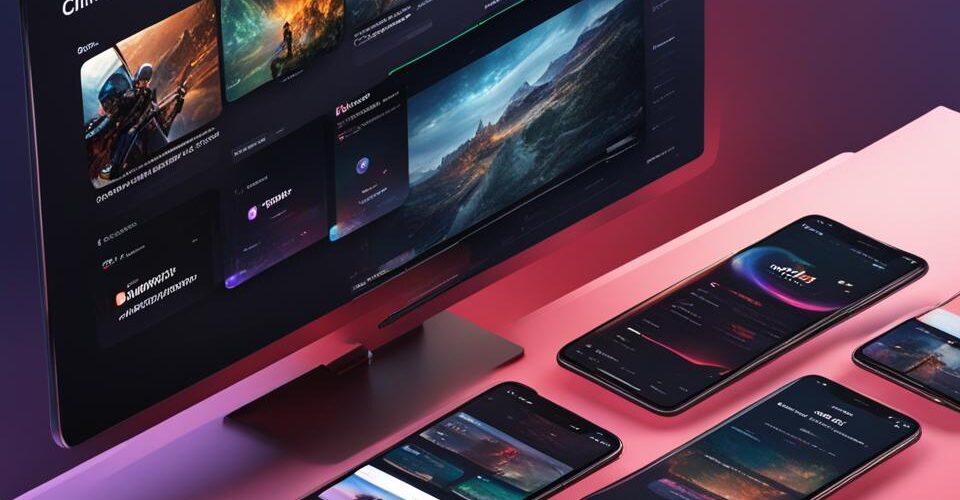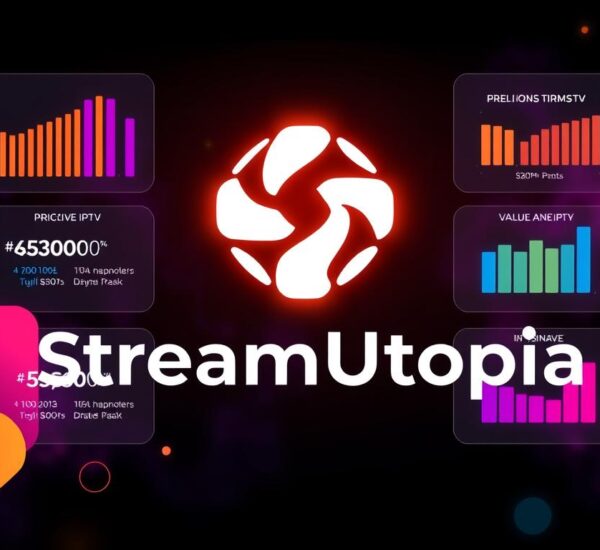Did you know that the global video streaming market is projected to reach a staggering $184.3 billion by 2027? With the increasing popularity of online video content, delivering personalized and seamless streaming experiences has become a top priority for businesses and content providers.
Adaptive streaming, a technology that allows for tailored content delivery based on each viewer’s streaming capabilities, is revolutionizing the way videos are streamed. By optimizing video quality in real-time, adaptive streaming ensures a seamless viewing experience even in fluctuating network conditions.
In this article, we will explore how adaptive bitrate streaming works, its benefits, popular streaming protocols that support it, and its comparisons to other streaming methods. We will also discuss the considerations and alternatives to adaptive streaming, as well as why businesses should consider incorporating this technology into their streaming strategies.
So, if you’re ready to dive into the world of adaptive streaming and learn how it can transform your video delivery, let’s get started!
Key Takeaways:
- Adaptive streaming enables tailored content delivery based on individual viewer’s streaming capabilities
- It optimizes video quality in real-time, ensuring a seamless viewing experience
- Adaptive streaming is supported by popular streaming protocols like HTTP Live Streaming (HLS) and Dynamic Adaptive Streaming over HTTP (MPEG-DASH)
- Compared to other streaming methods, adaptive streaming offers improved user experience and video quality optimization
- Considerations for adaptive streaming include choosing the right streaming protocols and optimizing video encoding and segmenting
How Does Adaptive Bitrate Streaming Work?
Adaptive bitrate streaming, also known as dynamic adaptive bitrate streaming, is a sophisticated technique that ensures a seamless video streaming experience for viewers across different network conditions. This process involves video transcoding, creating multiple versions of a video at various bitrates, and dividing them into segments.
During playback, the streaming player selects the appropriate segment and bitrate based on the viewer’s network conditions. If the network conditions change, the player can seamlessly switch to a different segment with a higher or lower bitrate, ensuring smooth playback without buffering. This adaptive approach ensures that viewers receive the best possible video quality while eliminating interruptions and optimizing the viewing experience.
Let’s take a closer look at each component that contributes to the success of adaptive bitrate streaming:
Video Transcoding
Video transcoding is a fundamental process in adaptive streaming. It involves converting a video file into multiple versions, each encoded at different bitrates. These different versions, also known as representations, are created to accommodate varying network speeds and viewer preferences. By having multiple representations, adaptive streaming can dynamically switch between them to provide the best possible quality based on the viewer’s network conditions.
Video Segments
Adaptive bitrate streaming divides videos into smaller segments, typically ranging from 2 to 10 seconds in duration. These segments allow for more efficient delivery and enable the streaming player to adapt to changing network conditions quickly. By using shorter segments, the player can seamlessly switch between them without noticeable interruptions, ensuring a smooth viewing experience.
| Component | Description |
|---|---|
| Video Transcoding | The process of converting a video file into multiple versions with different bitrates to accommodate varying network conditions. |
| Video Segments | The division of videos into smaller segments, usually 2 to 10 seconds long, to enable seamless switching based on network conditions. |
The combination of video transcoding and segmenting allows adaptive bitrate streaming to provide viewers with the best possible video quality throughout their streaming experience. By adapting to varying network conditions, adaptive streaming ensures continuous playback without buffering, providing an optimal viewing experience for users.
Benefits of Adaptive Bitrate Streaming
Adaptive bitrate streaming offers several benefits for both businesses and viewers. Firstly, it ensures continuous video playback without interruptions, even in fluctuating network conditions. This enhances the overall user experience and keeps viewers engaged with the content.
Additionally, adaptive streaming optimizes the video quality for each viewer, allowing them to watch videos in the highest possible quality that their network can support. This improves the visual experience and reflects positively on the brand or business.
To summarize, the benefits of adaptive bitrate streaming include:
- Optimized user experience, ensuring continuous video playback
- Improved video quality tailored to the viewer’s network capabilities
By leveraging adaptive bitrate streaming, businesses can provide an uninterrupted streaming experience and deliver high-quality videos that captivate their audience.
Adaptive Bitrate Streaming Protocols
Adaptive bitrate streaming can be implemented using different protocols. Two widely used protocols are HTTP Live Streaming (HLS) and Dynamic Adaptive Streaming over HTTP (MPEG-DASH).
HLS was initially developed by Apple but is now supported by various operating systems. It is commonly used for adaptive streaming on HTML5 video players.
MPEG-DASH, on the other hand, is an international standard that works across different browsers and supports any video codec.
Both protocols enable adaptive bitrate streaming and ensure a smooth playback experience.

Adaptive Bitrate Streaming vs. Other Streaming Methods
When it comes to delivering high-quality video content, there are various streaming methods available. Two alternatives to adaptive bitrate streaming are multi-bitrate streaming and progressive streaming.
Multi-Bitrate Streaming
In multi-bitrate streaming, viewers manually select the bitrate for the video. However, this bitrate remains constant throughout the playback, regardless of the viewer’s network conditions. This can lead to buffering issues and lower streaming quality if the network conditions change during playback.
Progressive Streaming
Progressive streaming involves delivering a single video file to all viewers, regardless of their device or network capabilities. This method does not dynamically adjust the video quality based on the viewer’s conditions. As a result, the video may stretch or squash, compromising the viewing experience and streaming quality.
On the other hand, adaptive bitrate streaming stands out by providing a more optimal viewing experience that takes into account the viewer’s network conditions. It dynamically adjusts the bitrate, ensuring continuous playback and improved streaming quality.
To understand the difference, imagine watching a video in a remote area with poor internet connectivity. With adaptive bitrate streaming, the video will automatically adjust the bitrate to a lower level to avoid buffering and ensure uninterrupted playback. In contrast, in multi-bitrate streaming or progressive streaming, the viewer would experience buffering or receive a lower-quality video file throughout the playback.
Adaptive bitrate streaming prioritizes the user experience, optimizing video quality for each viewer based on their network conditions. This approach ensures a seamless and enjoyable streaming experience, regardless of the viewer’s location or internet speed.
Note: The image above depicts a visual representation of streaming quality in adaptive bitrate streaming. It illustrates the dynamic adjustment of video bitrate based on the viewer’s network conditions.
Adaptive Bitrate Streaming and Streaming Protocols
Adaptive bitrate streaming relies on specific streaming protocols that support this technology. Two commonly used protocols are HTTP Live Streaming (HLS) and Dynamic Adaptive Streaming over HTTP (MPEG-DASH). These protocols utilize streaming profiles to determine the encoding and delivery settings for adaptive streaming.
Streaming profiles are essential in ensuring that the video content is optimized for adaptive bitrate streaming. These profiles define the characteristics of the video, such as resolution, bitrate, and segment length. They enable the streaming player to select the appropriate representation of the video based on the viewer’s device and network conditions.
There are two methods for selecting streaming profiles: automatic streaming profile selection and manual streaming profile selection.
Automatic streaming profile selection allows the streaming player to automatically choose the most suitable streaming profile based on the viewer’s device capabilities and network conditions. This ensures that the viewer receives the best possible video quality without interruptions or buffering.
Manual streaming profile selection gives content providers the flexibility to manually select the streaming profile for each video. This allows for more customization and control over the streaming experience, ensuring that specific quality requirements are met.
Both automatic and manual streaming profile selection methods have their advantages and are suitable for different scenarios. Automatic selection is efficient and scalable, while manual selection offers more fine-tuning options for specific streaming needs.
By utilizing streaming profiles and selecting the appropriate method for profile selection, adaptive bitrate streaming can deliver an optimized streaming experience to viewers, enhancing video quality and user satisfaction.
| Streaming Profile Selection Method | Advantages |
|---|---|
| Automatic Streaming Profile Selection |
|
| Manual Streaming Profile Selection |
|
Alternatives to Adaptive Bitrate Streaming
While adaptive bitrate streaming is an effective method for delivering tailored content, there are alternative streaming technologies available. These alternatives provide different approaches to video streaming, each with its own advantages and limitations. The choice of streaming method depends on various factors such as the target audience, content requirements, and infrastructure. Let’s explore some of these alternatives:
Progressive Download
Progressive download involves downloading the entire video file before playback starts. This method allows viewers to start watching the video immediately while the remaining portions continue to download in the background. However, progressive download does not dynamically adjust the video quality based on the viewer’s network conditions, which may lead to buffering or lower quality if the network cannot handle the streaming bitrate.
Smooth Streaming
Smooth streaming, also known as adaptive streaming with Microsoft’s Smooth Streaming protocol, dynamically adjusts the video quality based on the viewer’s available bandwidth. It divides the video into small fragments and ensures a seamless streaming experience by automatically switching to a different quality level based on the network conditions. Smooth streaming provides a more optimized viewing experience compared to progressive download, as it adapts to varying network speeds in real-time.
Static File Streaming
Static file streaming creates different versions of the video at various bitrates in advance. Each version is encoded separately and saved as a static file. Viewers can manually select the appropriate file based on their network capabilities and desired video quality. Static file streaming offers flexibility and control to the viewers, but it requires pre-encoding videos in multiple bitrates, which can be time-consuming and resource-intensive.
Peer-to-Peer Streaming
Peer-to-peer (P2P) streaming allows viewers to download parts of the video from multiple sources instead of relying solely on a centralized server. This reduces the load on the streaming server and improves scalability. P2P streaming can provide faster download speeds and increase the availability of video content. However, its effectiveness depends on the number of peers sharing the video and their network connectivity.
Each alternative streaming method offers unique features and benefits. The suitability of a particular method depends on the streaming requirements, available resources, and desired user experience. By evaluating these alternatives, businesses can choose the most appropriate streaming technology to deliver their content effectively.

In the next section, we will discuss the advantages of using adaptive bitrate streaming compared to other streaming methods.
Should You Use Adaptive Bitrate Streaming?
Adaptive bitrate streaming offers significant benefits for businesses looking to enhance their streaming experience. By incorporating this technology, you can ensure high-quality video playback, improve user engagement, and optimize streaming efficiency.
One of the primary advantages of adaptive bitrate streaming is its ability to deliver high-quality video playback. With adaptive streaming, the video quality adjusts in real-time based on the viewer’s network conditions. This ensures that viewers can enjoy optimal video quality without buffering or interruptions, providing a seamless and captivating viewing experience.
Improved user engagement is another key benefit of adaptive bitrate streaming. By reducing buffering and interruptions, adaptive streaming keeps viewers immersed in the content, increasing their engagement and satisfaction. With uninterrupted playback, viewers are more likely to stay engaged, watch the entire video, and potentially take desired actions such as sharing, subscribing, or making a purchase.
Adaptive bitrate streaming also optimizes streaming efficiency by dynamically adjusting to network conditions. When network bandwidth is limited, adaptive streaming automatically adjusts the bitrate to a lower level, preventing buffering and ensuring smooth playback. Conversely, when the network connection improves, adaptive streaming seamlessly adapts to higher bitrates, delivering superior video quality. This efficient use of network resources results in a more optimized streaming experience for both the viewer and the content provider.
By implementing adaptive bitrate streaming, businesses can deliver top-quality content to viewers while maintaining a professional image. Whether you are a media company, an e-learning platform, or a brand using video for marketing purposes, adaptive bitrate streaming ensures that your video content is presented at its best, leaving a lasting impact on your audience.
Advantages of Adaptive Bitrate Streaming:
- High-quality video playback tailored to the viewer’s network conditions
- Improved user engagement by reducing buffering and interruptions
- Optimized streaming efficiency by dynamically adjusting to network conditions
- Professional and impressive presentation of video content
| Aspect | Benefit |
|---|---|
| Video Quality | Deliver high-quality video playback with seamless adaptation |
| User Engagement | Keep viewers immersed in the content with reduced buffering and interruptions |
| Streaming Efficiency | Optimize network utilization by dynamically adjusting to network conditions |
Considerations for Adaptive Bitrate Streaming
When implementing adaptive bitrate streaming, there are several key considerations that businesses should keep in mind to ensure optimal performance and deliver a seamless streaming experience. These considerations include:
Streaming Protocols
Choosing the right streaming protocol is crucial for effective adaptive bitrate streaming. Two popular protocols are HTTP Live Streaming (HLS) and Dynamic Adaptive Streaming over HTTP (MPEG-DASH). HLS is widely supported by various operating systems and is commonly used for adaptive streaming on HTML5 video players. MPEG-DASH, on the other hand, is an international standard that offers cross-browser compatibility and supports any video codec. Selecting the appropriate protocol based on the target audience and platform can significantly impact the streaming performance.
Encoding Ladders
An encoding ladder is a set of video representations or versions at different bitrates. Creating an optimized encoding ladder is essential as it enables smooth adaptation between segments during playback. The encoding ladder should consist of representations that cater to different network conditions and device capabilities. By offering a diverse range of bitrates, the streaming player can seamlessly switch between representations, providing the viewer with the best possible quality based on their specific streaming capabilities.
Video Transcoding
Video transcoding is the process of converting video files from one format to another. It plays a vital role in adaptive bitrate streaming by ensuring that the video files are prepared correctly for adaptive playback. Transcoding involves encoding the video into multiple versions at various bitrates, which are used for adaptive streaming. This process ensures that the most appropriate video representation is delivered to the viewer based on their network conditions, resulting in a smooth and uninterrupted streaming experience.
Video Segments
Dividing the video content into segments is an integral part of adaptive bitrate streaming. These segments typically range from 2 to 10 seconds and allow the streaming player to switch between different representations seamlessly. By having shorter segments, the player can quickly adapt the video quality based on the viewer’s network conditions, avoiding buffering and providing a continuous and uninterrupted streaming experience. Proper segmentation ensures smooth transitions and improves the overall quality of the adaptive streaming.
By addressing these considerations, businesses can optimize their adaptive bitrate streaming implementation and deliver high-quality video content that adapts to viewer preferences and network conditions.
Conclusion
Adaptive bitrate streaming and personalized content delivery are key components in optimizing the viewing experience and ensuring the highest quality of video content. By utilizing adaptive streaming technology and selecting the appropriate streaming protocol, businesses can deliver top-notch video content that adjusts seamlessly to each viewer’s network conditions. This not only enhances user engagement but also reduces buffering, resulting in a smooth and uninterrupted streaming experience.
Implementing adaptive bitrate streaming is crucial for content delivery optimization, allowing businesses to stay at the forefront of streaming technology. By dynamically adjusting the video quality based on the viewer’s network capabilities, adaptive streaming ensures that the content is delivered in the optimal quality achievable. This translates to improved user satisfaction, longer viewing durations, and a positive brand image for the business.
As the demand for high-quality video content continues to rise, it is essential for businesses to embrace adaptive bitrate streaming as a means of optimizing content delivery. By incorporating this technology into their streaming infrastructure, businesses can provide a seamless and immersive viewing experience, keeping viewers engaged and satisfied. With the right streaming protocols and careful consideration of encoding and transcoding processes, businesses can make the most of the benefits offered by adaptive bitrate streaming, ensuring their content stands out in the competitive streaming landscape.
FAQ
What is adaptive streaming and personalized content delivery?
How does adaptive bitrate streaming work?
What are the benefits of adaptive bitrate streaming?
What are the adaptive bitrate streaming protocols?
How does adaptive bitrate streaming differ from other streaming methods?
How does adaptive bitrate streaming work with streaming protocols?
What are the alternatives to adaptive bitrate streaming?
Should I use adaptive bitrate streaming?
What considerations are important for adaptive bitrate streaming?
How does adaptive streaming optimize content delivery?





